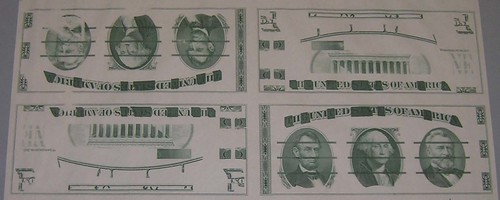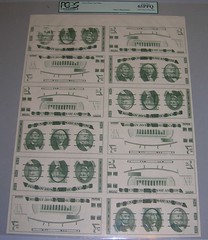
PREV ARTICLE
NEXT ARTICLE
FULL ISSUE
PREV FULL ISSUE
AMERICAN CAN COMPANY AND THE GIORI TEST NOTES
Many thanks to Nick Graver for alerting me to this article on Giori test notes from CHRONICLES, a publication on the Ontario County Historical Society, Canandaigua NY (www.ochs.org). It's reprinted here with the permission of author Wilma Townsend and OCHS Director Ed Varno. Thanks!
-Editor
What’s in the Collection?
“In 2012, Smitty's Coin and Currency, Canandaigua, NY announced the verification of a newly discovered hoard of Giori Test Notes that were printed on a press designed and built in Geneva in the 1970s. PCGS Currency, the most respected company in currency grading and authenticating, recently released some of the notes back to Smitty's. Being called the "Edgar L. Pigman Hoard", these notes are recognized to have significant local and national historical value. Until recently, these test notes were almost forgotten, with only the nephew of the late design engineer, Edgar L. Pigman, being aware of their existence. The American Bank Note Company, a subcontractor for the US Bureau of Engraving and Printing contracted Edgar, an engineer for the American Can Company's Geneva location, to design the press. These Geneva-made machines were shipped to Washington, DC and using "nonsense plates" from the BEP were used to print the notes in sheets of 32. These plates have about 30-34 different vintages from a variety of notes. Most recognized are Washington $1, Lincoln $5, and Grant $50 bills. These notes were not legal to possess since they somewhat resembled real currency, even though there were no denominations. Only with a change in the BEP policy are these rare notes now legal to be bought and sold. The History of the PCGS Certified Pigman Horde - Giori Test Note To understand the significance of the Giori test notes requires a little history of United States Currency. At the conclusion of WWII, Gualtiero Giori created what was eventually known as the Giori Press. This groundbreaking method allowed two-color and even three-color engraving from a single plate, in one pass. Using precisely cut special rubber inking rollers, this allowed the application of each ink selectively to parts of the same plate. Adding to the new faster drying ink and other new technologies, a new press was to be commissioned by the Bureau of Engraving and Printing (BEP), many times faster than anything before it. In a strange (and still not completely understood decision, American Bank Note Company (ABN) chose American Can as the subcontractor to actually create the new printing machines. Founded in 1901, the American Can Company was mostly known for the making of tin cans and their labels. They had manufacturing facilities nationwide, but chose the Geneva, NY plant as the site for building the press. Edgar L. Pigman (1932-2008) from Phelps, NY was selected as the American Can engineer to work on the project. Mr. Pigman designed the presses and tested them using the Giori process. These plates display approximately 32 different vignettes, including portraits of Presidents Washington, Lincoln and Grant that are identical to those on the $1, $5 and $50 Federal Reserve Notes that were then current in circulation. While the presses worked fine in Geneva (making these test notes), and were delivered to DC, they were never used for making any currency that went into circulation. There is no proof the presses were ever used once they made it to Washington DC.
 Many stories have circulated about the entire situation, and all are not completely understood or officially confirmed. It does not seem coincidental that this large waste of taxpayer dollars was soon followed by the Director of the BEP resigning, and a well-documented lawsuit to follow against him. Pigman's nephew talked about his uncle being unhappy about the entire situation, even though he had long since moved on to other projects. The test notes sat in his closet, undisturbed for 30+ years. Originally they were considered by the BEP as illegal for collectors own, since they somewhat resembled authentic circulating currency, but the restriction on private ownership has since been lifted. The test notes in this portfolio are one of the largest groups to ever become available to the collection community.”
If you would to see the sheet of Giori test notes, please call 585 394-4975 or email curator@ochs.org.
The Numismatic Bibliomania Society is a non-profit organization promoting numismatic literature. See our web site at coinbooks.org. To submit items for publication in The E-Sylum, write to the Editor at this address: whomren@gmail.com To subscribe go to: https://my.binhost.com/lists/listinfo/esylum All Rights Reserved. NBS Home Page Contact the NBS webmaster 
|
